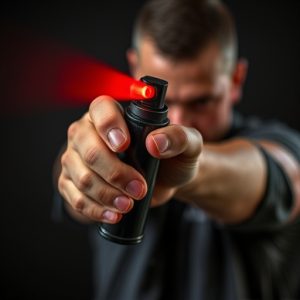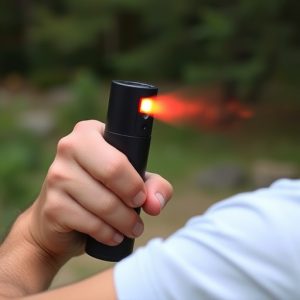Pepper Spray in Law Enforcement: Concentrations, Regulations, & Ethics
Riot control agents, like pepper spray, are chemical compounds used by law enforcement to manage cro…….
Riot control agents, like pepper spray, are chemical compounds used by law enforcement to manage crowds during civil disturbances. The effectiveness of these agents is linked to their concentration in capsaicin units (capsaicin units), with the strongest legal limit varying by jurisdiction. Typically ranging from 0.2% to 2%, this concentration plays a crucial role in crowd control while requiring careful regulation to balance potency and safety. Law enforcement agencies strictly regulate riot control agents, including training officers on safe handling, de-escalation techniques, and appropriate use cases, ensuring the deployment of these powerful tools remains proportionate and lawful. Future trends focus on advanced pepper spray technologies with higher concentrations and data analytics for proactive civil unrest management.
Riot control agents, particularly pepper spray, have become integral tools in law enforcement tactics. This article explores the legal dimensions of these powerful substances, focusing on the understanding, regulation, and ethical implications of their use. We delve into the science behind riot control agents, with a specific emphasis on the strongest legal pepper spray concentration and its impact on effective and safe law enforcement. Additionally, we examine the evolving regulatory landscape and predict future trends in riot control strategies.
- Understanding Riot Control Agents: A Legal Perspective
- The Role of Pepper Spray in Law Enforcement
- Strongest Legal Pepper Spray Concentration: What Matters?
- Regulatory Framework for Riot Control Agent Use
- Ethical Considerations and Future Trends in Riot Control
Understanding Riot Control Agents: A Legal Perspective
Riot control agents, a class of chemical compounds, are employed by law enforcement to manage and disperse crowds during civil disturbances or high-tension situations. These agents, often referred to as pepper spray, work by irritating the eyes, nose, and respiratory system, temporarily incapacitating individuals and facilitating crowd control. From a legal perspective, the use of riot control agents is carefully regulated to ensure public safety and respect for individual rights.
The strongest legal pepper spray concentration, typically measured in capsaicin units, is subject to varying legal limits across jurisdictions. These regulations govern not only the potency of the spray but also the circumstances under which it can be deployed. Law enforcement agencies must adhere to strict protocols, ensuring that the use of riot control agents is proportional and necessary for maintaining public order. Understanding these legal parameters is crucial for both law enforcers and citizens alike, as it shapes the tactical decisions made during high-risk situations.
The Role of Pepper Spray in Law Enforcement
In law enforcement, pepper spray—officially known as oleoresin capsaicin (OC) spray—serves as a critical non-lethal riot control agent. Its primary role is to temporarily disable or deter aggressive individuals, providing officers with time and space to de-escalate volatile situations. The effectiveness of pepper spray lies in its strongest legal concentration, typically measured in percent capsaicin, which can range from 1.3% to 2.5%. This concentrated formula enables law enforcement to handle high-risk scenarios, such as crowd control during protests or direct confrontations with armed suspects, without resorting to lethal force.
The use of pepper spray is carefully regulated to ensure public safety and minimize harm. Officers are trained in its application, ensuring they employ it only when necessary. Key factors in the success of pepper spray include proper training, appropriate distance, and understanding the individual’s level of resistance or aggression. With continuous advancements in formulation and delivery systems, law enforcement agencies worldwide rely on pepper spray as a versatile tool to maintain public order while upholding constitutional rights.
Strongest Legal Pepper Spray Concentration: What Matters?
When it comes to riot control and law enforcement, the strongest legal pepper spray concentration is a key consideration. The effectiveness of pepper spray lies in its capsaicin content, which disrupts normal respiration and causes intense pain. Concentrations typically range from 0.2% to 2%, with higher percentages offering more potent effects. However, it’s crucial to balance this strength with safety and legal constraints.
Law enforcement agencies must adhere to specific regulations regarding pepper spray usage, including limits on concentration levels. The strongest legal concentration allows for swift and effective crowd control in high-risk situations but must be deployed responsibly to prevent unnecessary harm or misuse. Understanding these concentrations is essential for officers to make informed decisions during operations, ensuring the safety of both citizens and law enforcement personnel.
Regulatory Framework for Riot Control Agent Use
The use of riot control agents, including pepper spray, is tightly regulated by law enforcement agencies to ensure public safety and accountability. The regulatory framework involves stringent guidelines on product quality, deployment protocols, and legal limitations on concentration levels. In many jurisdictions, the strongest legal pepper spray concentration is capped at 2%, with exceptions made only for specialized units dealing with extreme threats. These regulations aim to balance the need for effective crowd control with the risk of excessive force, protecting both officers and citizens from potential harm.
Legal frameworks also mandate comprehensive training for officers on safe handling, de-escalation techniques, and appropriate use cases. This includes protocols for when and how to deploy riot control agents, with a strong emphasis on using the minimum force necessary. The regulatory landscape continues to evolve, reflecting a dynamic approach to ensuring that the use of these powerful tools remains proportionate and legal, upholding the rights and safety of all involved.
Ethical Considerations and Future Trends in Riot Control
As law enforcement agencies continue to grapple with the challenge of riot control, ethical considerations and future trends are shaping the way these powerful tools are employed. The use of riot control agents, particularly pepper spray, raises important questions about balance, necessity, and proportionality in maintaining public order. With an increasing focus on de-escalation tactics, officers are being trained to utilize non-lethal force as a first resort. This shift prioritizes the safety of both civilians and law enforcement, minimizing potential harm while effectively managing disturbances.
Looking ahead, the development of advanced pepper spray technologies, including those with higher concentrations like the strongest legal pepper spray concentration available, offers enhanced efficacy and improved safety profiles. These innovations aim to reduce the amount of agent needed to subdue individuals, thereby minimizing collateral damage and ensuring better control in chaotic situations. Additionally, the integration of data analytics and predictive modeling could enable more strategic and effective riot control planning, paving the way for a future where law enforcement agencies can anticipate and proactively address potential civil unrest.
Riot control agents, particularly pepper spray, play a significant role in law enforcement strategies worldwide. With a thorough understanding of their legal framework and ethical implications, as highlighted in this article, it’s evident that the strongest legal pepper spray concentration is not solely a matter of potency but also of responsible use. The regulatory landscape ensures a balance between public safety and individual rights. As technology advances, future trends in riot control agents will likely focus on improving precision, minimizing harm, and enhancing accountability, thereby fostering more effective and ethical law enforcement practices.

